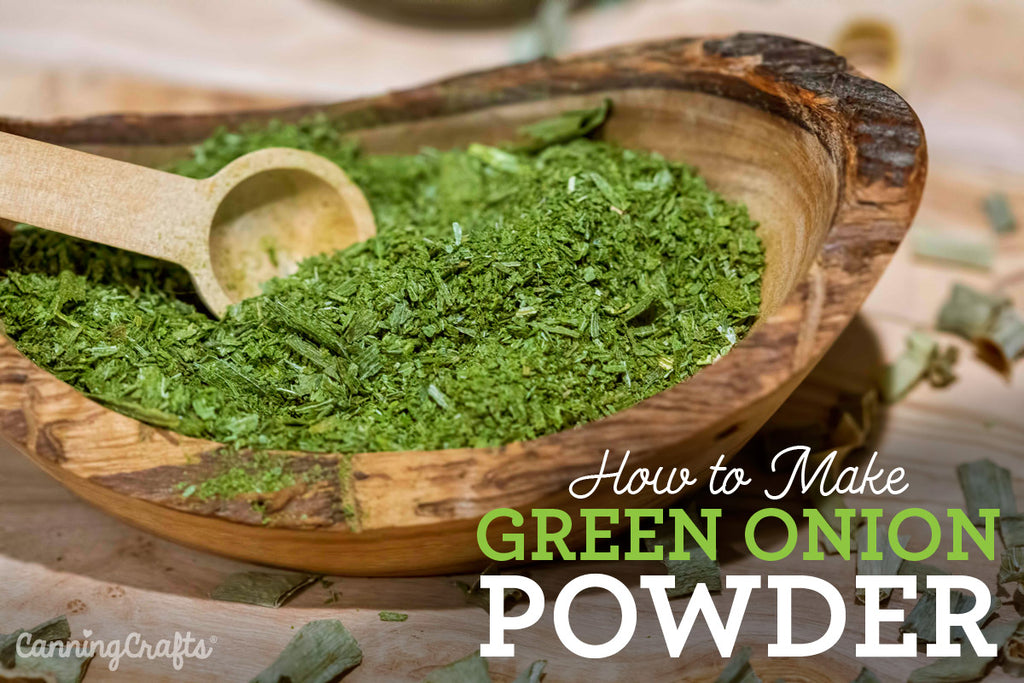How to Grow an Herbal Tea Garden
28. March 2024Guest Blog Post. Amy is the Director of Marketing and Communications for Joe Lamp’l (AKA joegardener®). In her spare time she gardens and practices her nature photography in a small suburban backyard in Northeastern Oklahoma with her dog Scarecrow. Amy’s new website and blog Toad and Sage Garden is where she features her garden photography and writes about ecological gardening and growing herbs, vegetables, flowers, and native plants in a suburban backyard.
If you’re a tea lover and also an herb gardener, it only makes sense to take your passion to the next level and grow your own herbs for tea. Years ago when I first fell in love with growing herbs, every herb I grew was to use in cooking. I also enjoyed sipping hot herbal teas, especially in the fall and winter. So at some point in my gardening journey, I started using my own homegrown herbs for herbal teas and infusions instead of just spice blends. That sparked a lifelong interest in learning more about herbs and growing as many as I could fit into my garden.
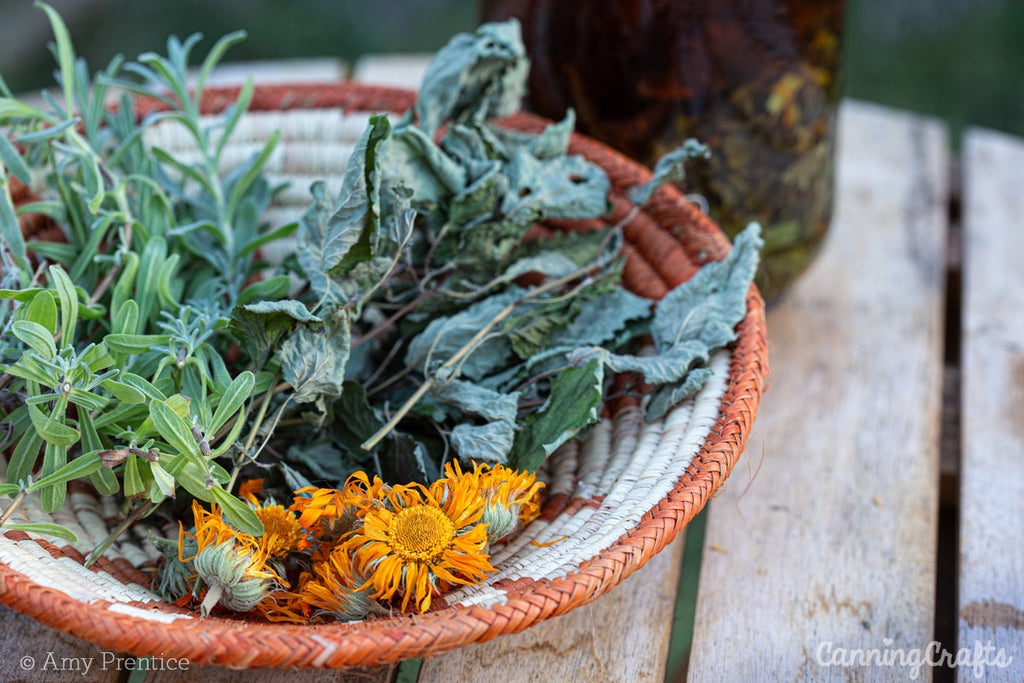
A basket of dried calendula blossoms, dried peppermint, and fresh lavender.
Imagine stepping outside into your own backyard and plucking fresh herbs to create your very own herbal tea blend. With a tea garden, you can cultivate a wide variety of herbs and plants that are perfect for brewing delicious and aromatic teas. In this article, we will explore the joy of growing your own tea herbs in your garden, selecting what herbs to grow, using them in tea infusions, and harvesting and drying them for future use.
Benefits of Growing Your Own Tea Herbs
Growing your own tea herbs offers a multitude of benefits that go beyond the pleasure of sipping a freshly brewed cup of tea. Here are some of the advantages I’ve discovered over the years:
- Quality and Freshness: When you grow your own tea herbs, you have complete control over the quality and freshness of the ingredients you use. You can ensure that your herbs are free from pesticides, chemicals, and other harmful substances, resulting in a healthier and more flavorful tea.
- Cost-Effective: Purchasing herbal teas or even just fresh or dried herbs from the store can add up over time. By growing your own tea herbs, you can save money and enjoy an endless supply of fresh ingredients right at your fingertips.
- Sustainability: By cultivating your own tea garden, you contribute to a more sustainable lifestyle. You reduce your carbon footprint by eliminating the need for transportation and packaging associated with store-bought teas.
- Connection with Nature: Gardening is a wonderful way to connect with nature and experience the satisfaction of nurturing and harvesting your own plants. As an added bonus, when herbs flower, they bring in a myriad of pollinators. Mint flower is a favorite of bees and beneficial wasps in my garden.
- Customization and Creativity: Growing your own tea herbs allows you to experiment with different flavors and create unique blends tailored to your preferences. By growing herbs from seed, you’ll be able to grow varieties that you’d never be able to find at your local big box store or gardening center. You can combine herbs to enhance taste, aroma, and even therapeutic properties, giving you endless possibilities for creating your perfect cup of tea.

Decorate your herbal collection jars with Custom Apothecary Labels or Herb Labels from CanningCrafts.
Choosing the Right Herbs for Your Tea Garden
When it comes to selecting herbs for your tea garden, the options are vast and it helps to research the flavors, energetics, actions, and side effects of different herbs. But nothing beats growing and experiencing them first hand, so experiment and don’t be afraid to try different herbs. Here are a few herbs that I grow in my garden for tea:
- Lemon Balm: Lemon balm, with its soothing lemony scent, is a must-have herb for any tea garden. Besides being delicious, it is known for its calming properties and is often used to relieve stress and promote relaxation.
- Peppermint: Peppermint is a refreshing and invigorating herb that adds a delightful minty flavor to your tea. It is used to aid in digestion, soothe headaches, and provide a cooling sensation. It’s an herb I use for a mild tummy ache.
- Chamomile: Chamomile is renowned for its calming and sleep-inducing properties. It has a gentle, floral taste and is often used to promote relaxation and reduce anxiety. I find that it smells and tastes a bit like apples with a hint of honey. It’s a must-grow in my garden and luckily reseeds every year.
- Lavender: Lavender not only adds a beautiful aroma to your tea but also offers calming and mood-lifting effects. It is often used to alleviate stress and support restful sleep.
- Nettle: Nettle is a nutrient-rich herb that is packed with vitamins and minerals. It is known for its detoxifying properties and is commonly used to support healthy skin, hair, and nails. Be sure to use gloves when harvesting the stinging variety of nettle. Allowing the nettles to wilt slightly takes some of the bite out of its needles.
- Rosemary: Choosing a favorite herb is kind of like picking a favorite kid, but rosemary is definitely my most-loved herb. Shhh, don’t tell the others! It adds a fragrant and slightly pine-like flavor to your tea. It is known for its cognitive-enhancing properties and is believed to improve memory and focus. It’s one of my favorite herbs to grow for both tea and cooking, and it’s just so beautiful when it flowers.
- Tulsi Basil: Also known as holy basil, Tulsi is a favorite herb in my tea garden. There are lots of varieties of Tulsi basil but the one I grow from seed is a powerful, sweet aromatic called Temperate Tulsi (Ocimum africanum). In my climate it self-seeds every year and is so delicious I even add it to my morning smoothies.
That’s a good short list of herbs anyone can easily grow to get started with a tea garden. As time goes on, you may be inspired to try others and to start herbs from seed. I’ve grown and experimented with other herbs over the years such as valerian root, mugwort, lemon verbena, sage, and mullein to name a few.
Remember to choose herbs that thrive in your specific climate and growing conditions. Consider factors such as sunlight, soil type, and water requirements when selecting herbs for your tea garden.
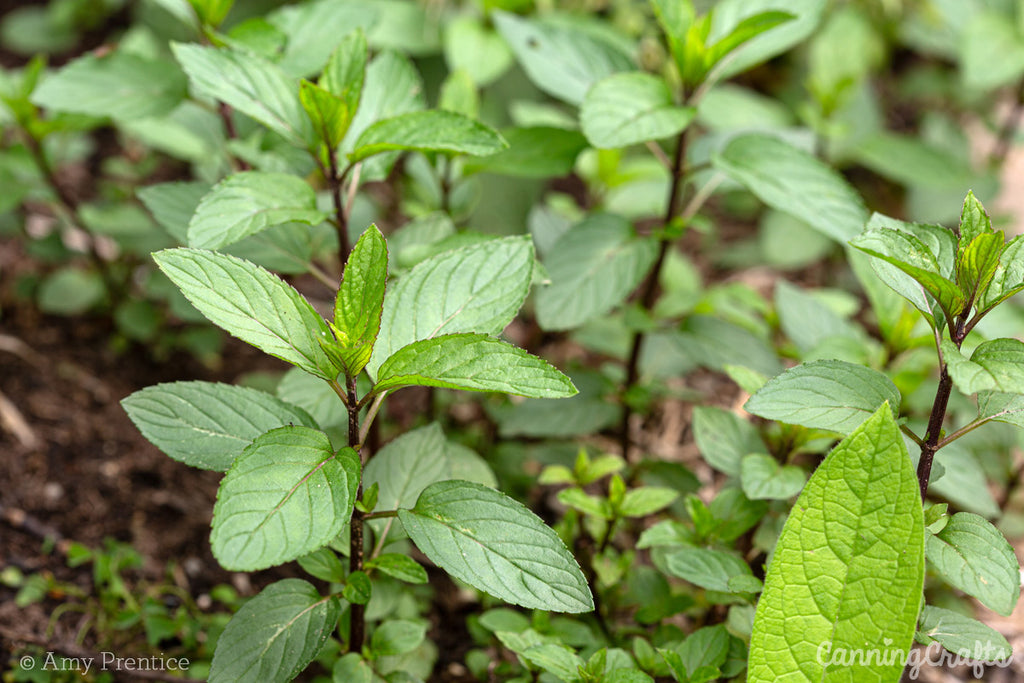
Peppermint growing in the garden
Essential Tips for Successful Herb Gardening
To ensure the success of your tea garden, it's important to follow some essential tips for herb gardening. Keep in mind that many of the common herbs we grow are from the Mediterranean region. They grow well in full sun, well-drained soil, and dry summers but not too dry. Here are some key guidelines to keep in mind:
- Choose the Right Location: Most herbs thrive in full sun, so select a location in your garden that receives at least six hours of direct sunlight each day. Ensure that the soil is well-draining to prevent waterlogged roots.
- Prepare the Soil: Before planting your herbs, prepare the soil by removing any weeds or debris. Add organic matter such as compost or well-rotted manure to enrich the soil and improve drainage.
- Provide Adequate Water: Herbs generally prefer slightly dry conditions, so be careful not to overwater them. Water the plants deeply but infrequently, allowing the soil to dry out slightly between waterings.
- Mulch and Weed Regularly: Mulch is my secret gardening weapon in the hot climate where I grow. Mulching around your herbs helps retain moisture in the soil, suppress weeds, and keep soil temperature cool in summer.
- Prune and Harvest Regularly: Herbs love to be pruned! Regular pruning and harvesting promotes healthy growth and prevents your herbs from becoming overgrown. Pinch off the tips of the plants to encourage bushier growth, and harvest leaves and flowers as needed.
- Amend Your Soil: Many herbs are perennial or reseed so they come back year after year in the same location. Pay attention to the health of your soil, adding organic nutrients from sources like compost as needed to maintain soil fertility and prevent nutrient depletion. However, I have found that most herbs don’t need (or like) to be fertilized often but I do top dress with compost once or twice a year to add nitrogen and other nutrients back to the soil.
By following these essential tips, you'll create an optimal environment for your tea herbs to flourish and provide you with an abundant harvest.
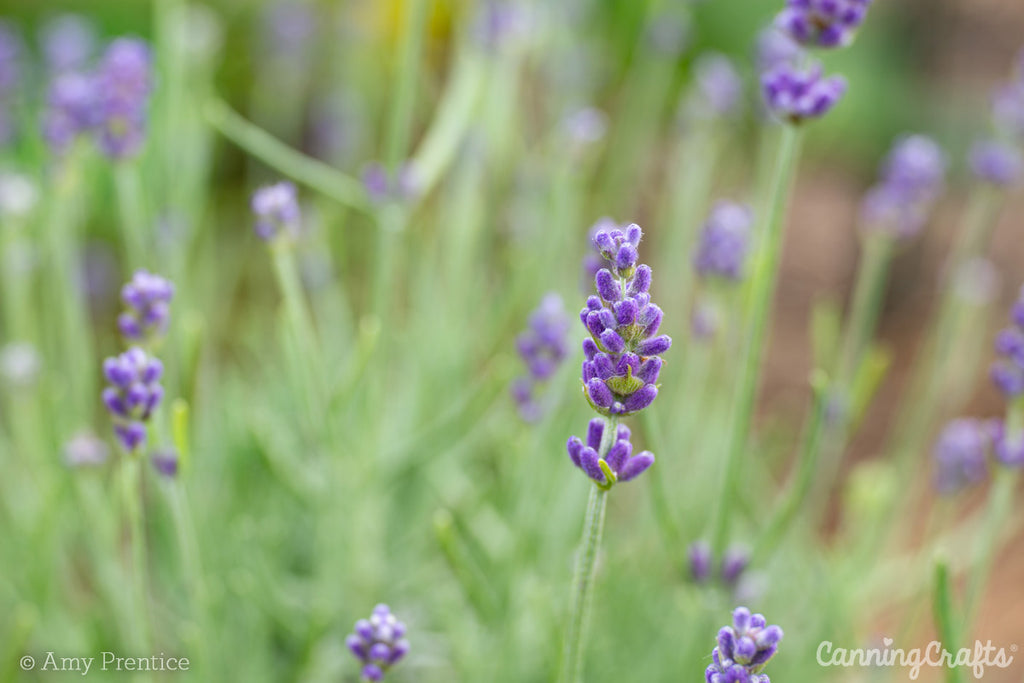
Lavender flowers in the garden
How to Plant and Care for Tea Herbs
Now that you've selected your preferred tea herbs and prepared your garden, it's time to learn how to plant and care for them. Here's a step-by-step guide to help you get started:
- Start from Seeds or Seedlings: You can either start your tea herbs from seeds or purchase seedlings from a local nursery. Although I prefer to start as many plants as I can from seed, some herbs such as rosemary grow very slowly. I am fortunate to have an organic farm nearby where I source some of my herb seedlings. I’ve also had luck ordering herb plants online from trusted sources like Strictly Medicinals. Follow the instructions on the seed packet or consult the nursery for specific growing guidelines.
- Prepare the Planting Holes: Dig small holes in the soil, spacing them according to the recommended distance for each herb. Gently loosen the roots of the seedlings before placing them in the holes.
- Plant at the Right Depth: Ensure that you plant the herbs at the same depth they were growing in their containers. Backfill the soil around the planting hole and lightly press the soil around the seedlings.
- Water Thoroughly: After planting, water the herbs thoroughly to settle the soil and provide moisture to the roots. Be careful not to overwater, as excessive moisture can lead to root rot. If growing in containers like pots, grow bags, or whisky barrels, you may need to water more frequently in hot dry conditions.
- Provide Support if Needed: Some herbs, such as lavender or taller varieties of mint, may require support to prevent them from falling over. Insert small stakes or plant supports near the base of the herbs to provide stability.
- Monitor and Maintain: Regularly monitor your tea herbs for signs of pests, diseases, overwatering, or nutrient deficiencies. Remove any damaged or diseased leaves and provide appropriate care.
One note about pests: It’s no fun to walk out to the garden one morning and see a beloved herb plant being eaten by a caterpillar. However, keep in mind that many herbs serve as host plants for butterflies. I learned this years ago when I found caterpillars had just about eaten every leaf on my parsley plant. But with further research, I learned that they were the larva of Papilio polyxenes, the black swallowtail butterfly. I would later discover that their host plants also include fennel, dill, angelica, carrots, parsnips and others in the Apiaceae family.
Because I’m an ecological gardener, I garden in partnership with nature and recognize that all life in the garden is part of a balanced food web and ecosystem. My solution is to plant extra herbs for the caterpillars and to always check all leaves for eggs or newly hatched caterpillars before harvesting.
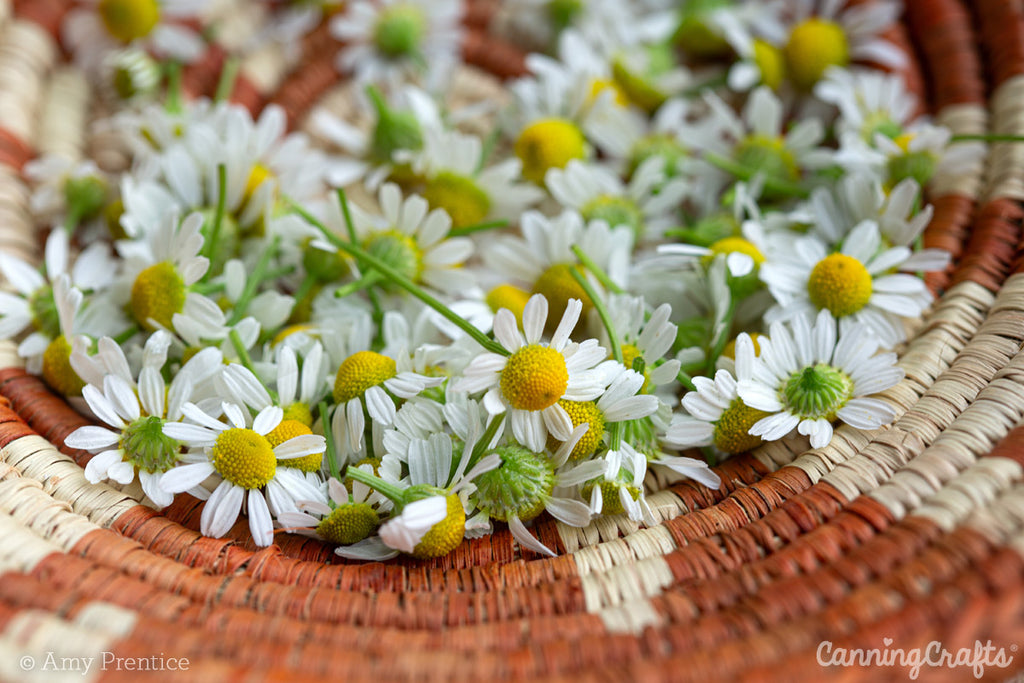
Basket of freshly harvested chamomile flower to be dried for tea.
Harvesting and Drying Your Tea Herbs
When we think of herbal tea, we often associate it with dried plants because that’s how you buy them at the store. That makes sense because they can be preserved longer that way. However, with a tea herb garden right outside your back door, you have the option to use fresh herbs all during the growing season.
But if you want to harvest, preserve, and store herbs for use later when the garden is dormant, the key to preserving the flavors and therapeutic properties of your tea herbs lies in proper harvesting and drying techniques. Drying herbs also allow you to give a homegrown herbal tea blend as a gift. Here's how to harvest and dry your herbs for future use:
- Choose the Right Time: Harvest your tea herbs in the morning, after the dew has evaporated but before the heat of the day. This is when the essential oils are at their peak concentration.
- Use Clean Tools: Use clean pruning shears or scissors to cut the herbs. This helps prevent the spread of diseases and ensures a clean cut that promotes healthy regrowth.
- Harvest Selectively: Harvest the leaves and flowers of your herbs, leaving some behind for continued growth. I always try to avoid harvesting more than one-third of the plant at a time to maintain its vitality. I cut the tips above a growing node to promote a bushier growth pattern.
- Dry the Herbs: There are several methods for drying herbs, including air drying, using a dehydrator or oven on the lowest temperature, or creating a drying rack. Choose the method that works best for you and your available resources.
- Air Drying: Bundle small bunches of herbs together and hang them upside down in a cool, well-ventilated area. Ensure that the bundles are not too large, as this can hinder airflow and lead to mold or spoilage. This is my favorite method of drying herbs. Especially those that dry quickly.
- Dehydrator Drying: I like the dehydrator for faster drying of herbs that hold more moisture in their leaves. If you have a dehydrator, spread the herbs in a single layer on the trays and set the temperature to the appropriate setting for that herb. Follow the manufacturer's instructions for drying times. As a rule, I dry on a low setting for all herbs to retain their flavor and color.
- Drying Rack: Create a drying rack by laying the herbs on a clean surface, such as a mesh screen or paper towels, in a warm, dry area. Turn the herbs occasionally to ensure even drying.
- Store Properly: Once the herbs are completely dry, they will break or crumble rather than bend. Remove any stems or debris and store them in airtight containers, such as glass jars or resealable bags. Keep the containers in a cool, dark place to maintain the herbs' quality and potency. Be sure to label with the herb’s name and date of storage.
By harvesting and drying your tea herbs correctly, you can enjoy their flavors and benefits throughout the year, even when the growing season has ended.

Decorate your herbal collection jars with Custom Apothecary Labels, Custom Market Blend Labels, or Herb Labels from CanningCrafts.
Creating Your Own Herbal Tea Blends
Now that you have a collection of dried tea herbs, it's time to get creative and start blending your own herbal teas. Here are some tips to help you create unique and flavorful tea blends:
- Start with a Base Herb: Choose a base herb that will form the foundation of your blend. This herb will provide the main flavor and characteristics of your tea. Examples of base herbs include chamomile, peppermint, or nettle.
- Add Supporting Herbs: Experiment with different combinations of supporting herbs to enhance the flavor and therapeutic properties of your tea. Consider herbs such as lemon balm, lavender, or rosemary to add complexity and depth.
- Balance the Flavors: Pay attention to the balance of flavors in your blend. Some herbs may have strong flavors, while others are more subtle. Adjust the ratios of each herb until you achieve the desired taste.
- Consider Therapeutic Effects: Take into account the therapeutic effects of the herbs you include in your blend. For example, if you're looking for a calming tea, consider adding chamomile or lavender. If you want an energizing blend, include herbs such as peppermint or rosemary. Also, keep in mind that herbs in high doses can have side effects. If you’re pregnant or taking any medications that could have interactions, be sure to research the constituents of any herbs you plan to use.
- Experiment with Complementary Ingredients: Don't be afraid to get creative and add complementary ingredients to your tea blends. Consider adding dried citrus peels, spices like cinnamon or ginger, or even edible flowers for visual appeal.
- Document Your Recipes: As you create different tea blends, make sure to document your recipes. Note down the ratios of each herb, brewing instructions, and any additional ingredients. This will help you replicate your favorite blends in the future.
Remember, the beauty of blending your own herbal teas lies in the ability to customize and experiment. Don't be afraid to try new combinations and trust your taste buds to guide you towards creating unique and delightful flavors.
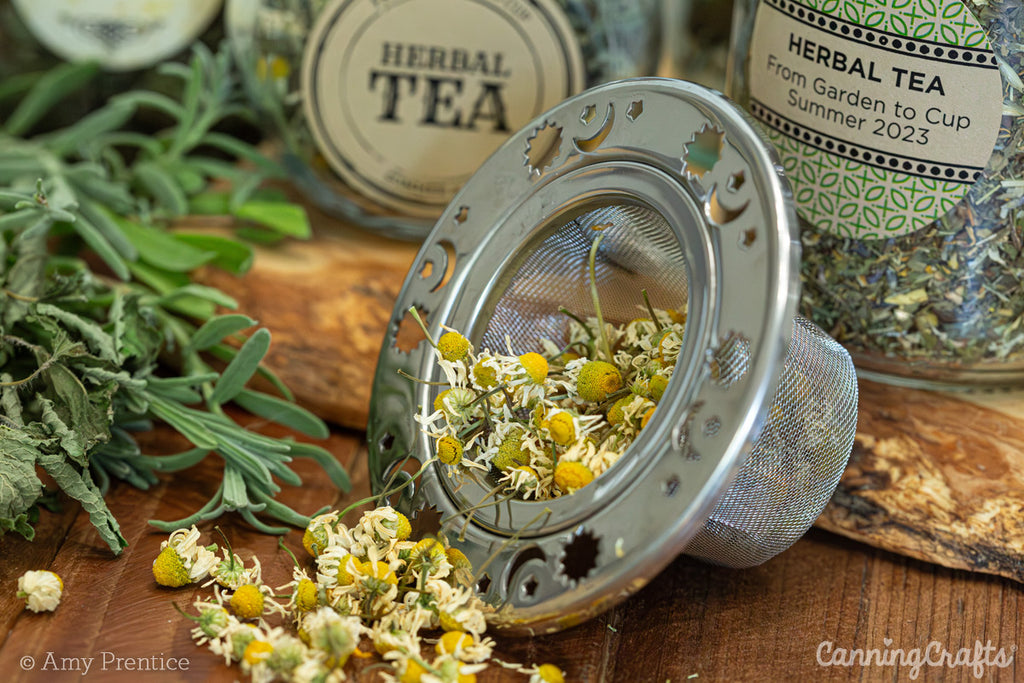
Celestial tea strainer from Mountain Rose Herbs with dried chamomile blossoms.
How to Use Your Homegrown Tea Herbs
Now that you have your tea herbs and blends ready, here are three ways to infuse them to create herbal tea.
Hot Water Infusion
- In a pot or kettle, bring water to a boil.
- Place herbs in a mug or teapot loose or using a mesh tea ball.
- Pour hot water over the herbs once the water stops boiling.
- Cover the infusion to trap the herb’s volatile oils.
- Steep for 5 or 10 minutes or overnight if you’re making a stronger dose infusion.
- If using loose leaves, filter the tea with a tea strainer pressing down on the plant material with the back of a spoon to get all the liquid out.
Herbal Iced Tea
- Steep 2 tablespoons of your herbal tea blend in a few cups of hot water
- Once steeped, strain the tea and add sweetener to taste stirring until dissolved.
- Let it cool to room temperature, pour the tea into a pitcher, and refrigerate until chilled.
- Serve over ice and garnish with fresh lemon or lime slices, if desired.

Jar of solar brewed tea.
Solar Infusion
- Add your herbs to a glass quart jar and fill with cold water.
- Place the lid on tight and set the jar in a sunny spot in your garden for several hours.
- Use a tea strainer to filter the herbal infusion into your favorite cup.
- Squeeze out as much liquid as you can from the plant material by pressing down on the herbs with a spoon.
Those are just a few ways you can create herbal tea with your homegrown herbs. And besides the typical infusion in water, there are lots of other uses for homegrown tea herbs. Branch out into infusing herbs into vinegar, honey, and simple syrups to use as extra herbal additions to teas. Let your imagination guide you as you explore the endless possibilities of homegrown herbal teas in foods, drinks, and self-care rituals.
A note on safety: Be sure to use clean equipment and filtered or boiled water to reduce the chances of bacterial growth or contamination. For any herbal tea infusion, it is recommended to consume within 24 hours and store your tea in the refrigerator.

Press ‘N Brew tea bags from Mountain Rose Herbs with dried calendula flower.
Gifting Customized Blends
What better way to give the gift of your garden than a tea you made from herbs you cultivated. Simply gather your favorite dried tea herbs, whether it’s soothing chamomile, refreshing peppermint, or fragrant lavender, and pack them into press and brew tea bags. Seal them shut with a hot iron, and you have the perfect homemade tea bags.
To make it even more special, package your tea bags in a jar or gift basket along with a mug and some locally sourced raw honey for an extra touch of sweetness. Alternatively, you can make your favorite blend of herbs, skip the tea bags, and store the herbs in a mason or pantry jar with a cute label. Decorate your herbal collection jars with Custom Apothecary Labels, Custom Market Blend Labels, or Herb Labels from CanningCrafts. Gift with a charming tea strainer or vintage tea ball they can use to infuse the herbs.

Decorate your herbal collection jars with Custom Apothecary Labels, Custom Market Blend Labels, or Herb Labels from CanningCrafts.
From Garden to Cup
Creating your own herbal tea blends with the herbs you grow allows you to experience the joy of connecting with nature and the plants themselves. With these tips and techniques you can savor the flavors of freshly brewed tea, and reap the therapeutic benefits of the plants you grew in your own garden. So, roll up your sleeves, dig your hands into the soil, and experience the magic of growing herbal tea in your own backyard.

Shop for herb & spice jar labels in our shop.
Read our other blog post about how to Grow and Create Your Own Italian Seasoning Blend.
Read our other blog post on how to make Flavor Infused Vinegar and get our FREE Printable Hang Tags.
Read our other blog post on Growing Cilantro for Coriander.
Read our blog post on How to Make Green Onion Powder
Looking for more info on growing, drying, & cooking with herbs? Follow our Herb Gardening Tips & Recipes Pinterest Board.

Sign up for our newsletter to get free printables, gardening tips, herb gardening tips, recipes, product updates, & a 10% off coupon on your first order of canning labels in our shop.






